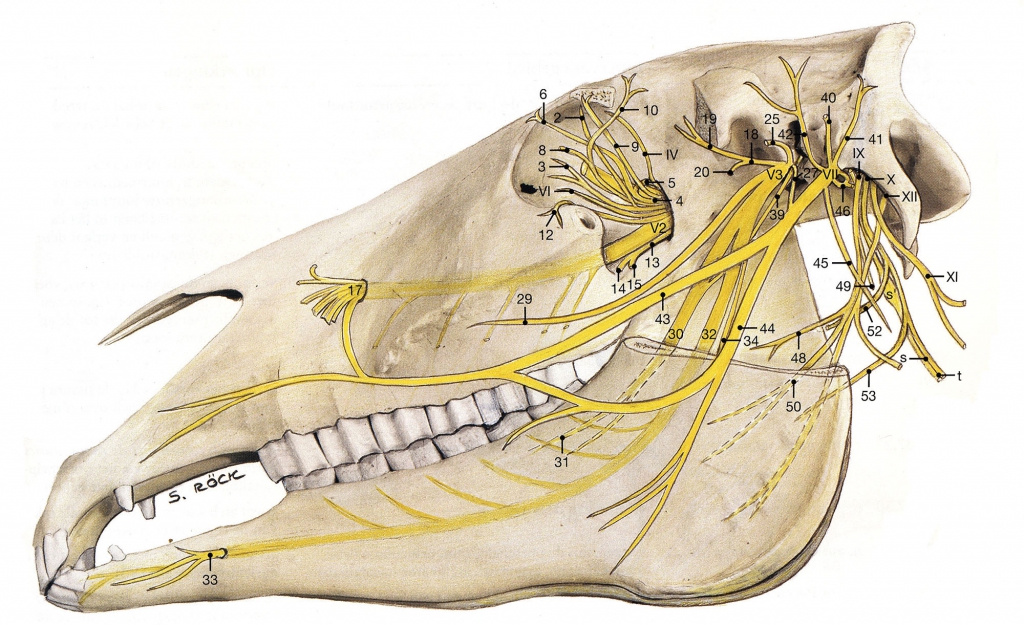Every potential cause of head shaking, nodding and tossing needs to be thoroughly assessed. It is therefore likely that a number of practitioners (as well as the owner) will need to be involved, and to work together to come up with the best possible plan for overcoming the problem. There is little to be gained if a ‘headshaker’ undergoes a program of behavioral re-training without first having its mouth examined from a dental perspective, assessment to rule out the possibility of an injury to the skull and the fit of its gear checked.
Then, of course, executing the remedial plan for a headshaking case is likely to require time, patience and persistence on everyone’s part as, in the majority of cases, there is no ‘quick fix’. In fact, the longer a horse has been exhibiting abnormal head movements, the more likely it is to have developed a multi-faceted problem.
The types of dental problems that contribute to head shaking or head tossing may relate to the horse’s age, in that younger horses (1-6 years) are still erupting adult teeth and, during this process, may show signs associated with pain. Usually, in this age group, any pain being experienced is due either to the shedding of teeth, an impacted tooth or sharp slivers of tooth roots left in the gum after teeth have been shed. Horses of all ages may exhibit head tossing behavior due to presence of upper wolf teeth, although this will usually be associated with a bit being in the mouth, or can suffer from fractures to the facial bones- most particularly, the jaw. Also, as mentioned in Part One of this article, equine teeth are innervated by (obtain their nerve supply from) the trigeminal nerve, which branches to supply the upper and lower teeth and the area around them – meaning that pain causing head tossing or shaking may be able to be traced back to this source.
Another potential cause of head shaking is tack – more specifically, the bit and bridle -as few owners take the time to properly assess the fit of these items.
The equine skull is a puzzle of 26 bones which are attached to each other through sutures. The sutures are like small joints that are designed to absorb and spread out the energy that occurs during head injury. Living bone is very flexible due to blood flow and fatty tissue.
The skull of a foal consists of even more bones, some of which only merge at the age of 5 or 6 years. Trauma or pressure to the skull of a young horse can have huge implications for future health.
The craniosacral perspective
In order to understand head shaking and its causes, it is important to realize that a horse’s skull (or cranium) is constantly exposed to more pressures than is any other part of the body. These pressures are predominantly applied by items such as bits, bridles and nosebands – often not fitted properly – or may arise from invasive procedures on the head, such as dental work or trauma, such as a head injury. As a result, there are compressive ‘flow-on’ effects to the individual bones of the skull, the surrounding soft tissue or muscles and the cranial nerves, which may ultimately contribute to the formation of a head shaking response.
Craniosacral therapy, a gentle and noninvasive technique using extremely light finger pressure, aims to feel and address imbalances in the body of the muscular skeletal system by acting on what is known as the craniosacral system – that is, the head, tailbone, spinal cord and spinal dura (the protective sheath surrounding the spinal cord).
When performed on horses that ‘headshake’, craniosacral therapy focuses on ‘opening up’ structures in the head that are being ‘tightened’ by excessive practices creating abnormal compressive forces. An example of this type of force is pressure being applied to the jaw by bit pressure or the muzzle area by a tight noseband, which will usually cause a horse to constantly try to open its mouth. This action tends to lead to increased muscle tension, a change in mastication (chewing) patterns and, ultimately, interference with the normal function of the temporomandibular (TMJ) joint.
As time goes on in the ‘noseband’ and bit scenario, the tight muscles associated with the TMJ joint and the bones of the cranium begin to put direct pressures on the temporal bone, where the trigeminal nerve is housed. Irritation to the trigeminal nerve is considered by some to be one of the major causative factors in the whole clinical picture of headshaking).
Craniosacral therapists believe that, if the degree of pressure on the temporal bone becomes high enough, trigeminal nerve can become ‘pinched’ due to tightening of the surrounding tissue – creating a ‘burning’ type of pain or intermittent ‘shooting’ of sharp pain in the head. This situation closely equates with how a migraine headache develops and feels in a human but, unfortunately, it isn’t easy for a horse to ‘pop a pill’ or race off to the physio when it feels one coming on! Headshaking, it seems, may simply be one way a horse tries to find relief.
Through injury and other pressures, the bones of the skull can become unbalanced.
The intermediate links can become pinched and affect nerves, sinuses, balance, function of the temporomandibular joint, head posture, neck and overall movement.
©2010 Maureen Rogers / Joey Philips


